
For businesses with an online presence, SEO is essential to getting your website seen. This is especially true for accounting firms, which increasingly don’t have a high-street presence or traditional marketing to fall back on.
The problem is that most firm owners don’t know enough about SEO to maximize the impact of their website. Getting to grips with SEO can seem overwhelming at first, but with the right tips and advice, you can turn your website into a high-performing revenue generator.
In this article, we’ll show you how.
What is SEO for accountants?
SEO stands for search engine optimization. It entails numerous strategies designed to ensure that your website shows up on search engine results pages (SERPs) like Google when people enter certain words or phrases, known as keywords.
Think of your website as an online store. To get people to visit your store and see what you offer, they need to know it exists. Unlike traditional stores, you can’t walk past a website on the way to the shop. SEO helps people who are potentially interested in what you offer to find your website.
The benefits of SEO for accountants
SEO is a big deal, but it often goes under the radar for many business owners, who think having a website is enough. Get it right, however, and you’ll unlock the following powerful benefits:
Organic traffic
Effective SEO sets the wheels in motion for a steady stream of traffic to your website. And if your website, services, and pricing look good, that means a steady stream of new clients. SEO blows most other lead-generation strategies out of the water, driving 1,000% more traffic than organic social media and performing significantly better than paid ads.
Limitless potential
Unlike paid ads or email campaigns that may cause temporary spikes in interest, SEO can engage new clients forever. By publishing regular blog posts and enhancing your content, you can drive fresh traffic to your website over time.
Cost-effectiveness
SEO is generally more cost-effective than paid advertising, such as Facebook Ads or Google Ads, especially if you can master the basics yourself. With SEO, you don’t have to pay for clicks, impressions, or engagement. You just get your website optimized, and traffic will find its way to you.
Key SEO strategies for accountants
So the benefits of SEO are clear. But how do you go about realizing those benefits? In this section, we’ll guide you through 16 SEO strategies that will help you attract new accounting clients.
1. Identify the right keywords
To optimize your website content, you need to identify the words and phrases that your target audience uses when searching for an accountant online.
If you’re an accounting firm based in Miami that specializes in individual tax returns, you want your website to appear on the first page of Google when someone types in “tax accountant in Miami”, for example. You can achieve this by placing this keyword strategically throughout your website.

Google search results for the keyword “Tax accountant in Miami”.
You’ll need to conduct thorough keyword research to understand exactly which keywords to target on your website. High-volume keywords, i.e. those with high monthly searches, are more competitive and therefore harder to rank for. Low-volume keywords tend to be more specific and detailed. They’re easier to rank for, but you are targeting a much smaller audience. Finding the right balance here is key.
There are tons of tools you can use to guide you through the keyword research process. Google Keyword Planner can help you analyze search volume and competitiveness, while tools like Ahrefs and Semrush offer more advanced features for keyword research.
Once you know which keywords you want to target, you’ll need to place them in web copy, titles, headers, descriptions, and URLs.
2. Optimize site structure
To drive traffic to your website, you’ll also need to pay attention to its structure. By that, we mean the different web pages that comprise your site and how they connect to one another.
Essentially, your website structure needs to cater to the type of things potential clients are searching for. For example, if you provide accounting services for small businesses and people are searching for “small business accounting”, it helps to have a dedicated web page for this keyword. The same goes for other services — as you can see in this example below.

Tailoring your website’s structure to address relevant keyword phrases increases your online visibility and ensures that your website content is aligned with what people are looking for.
Another effective SEO strategy is to create relevant title tags. A title tag is a critical HTML element that tells search engines the title (i.e. name) of a web page. HTML is the standard code used to structure web pages.
The title tag plays a significant role in search engines determining whether one of your web pages is relevant to what someone is looking for. Including keywords in your title tags can help improve the likelihood of your page ranking highly.
From the searcher’s side, the title tag is displayed in Google as the clickable headline for that webpage. With this in mind, an effective title tag combines the following:
- Highly relevant
- Includes keywords
- Describes what the page is about
- Not too long but not too short — about 50-60 characters is ideal
Here’s an example from one of our blog posts. The title tag is the purple clickable link.
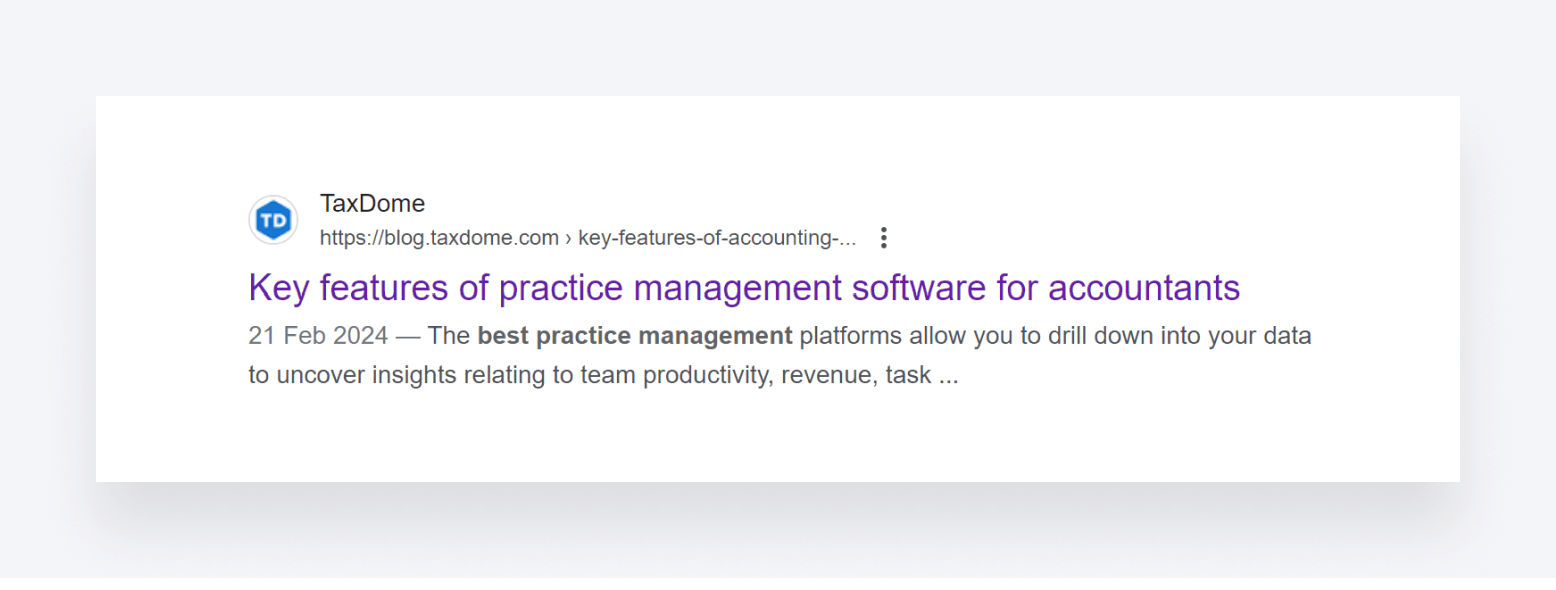
4. Create compelling SEO texts
To boost SEO visibility, you must sprinkle keywords throughout your website, making sure to include them in headings as well as main texts. This helps Google match your website with relevant search queries.
As always, however, balance is important. You should always avoid “keyword stuffing”, where you overdo keyword insertion at the expense of readability. From the reader’s perspective, your text should look natural. Keyword stuffing also affects SEO performance, with Google unlikely to rank your website highly if you overdo it.
In the example below, you can see that this website is targeting the keyword “tax planning services”, among others. The main text also includes phrases such as “tax planning”, “tax planning for business”, and “tax planning for individuals”. This helps align your web page with search queries relating to tax planning.

5. Integrate Google Search Console for valuable insights
Another critical yet often overlooked step in an effective SEO strategy is connecting your website to Google Search Console. This is a free web service that provides a range of tools to help you monitor and improve your website’s performance.
By connecting your website to Google Search Console, you gain access to useful insights. For example, you can see how your keyword rankings, click-through rates, and impressions change over time. You can also identify and troubleshoot problems with your website.
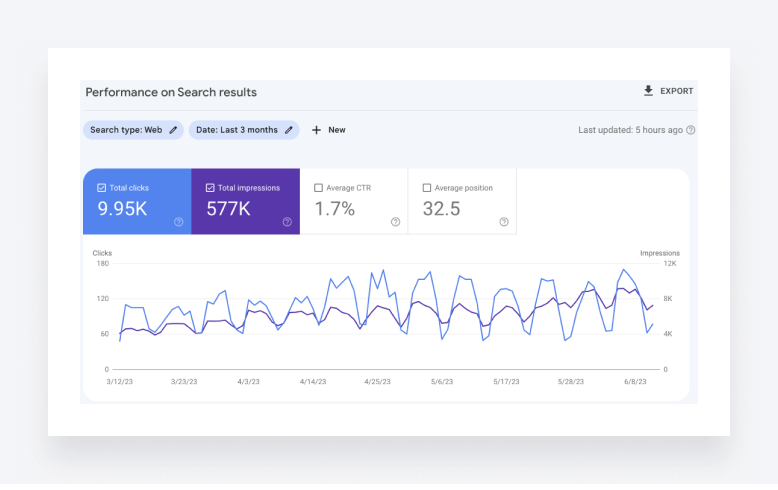
Here are some steps you can take to get set up with Google Search Console and maximize its potential.
Verify ownership of your website
First, you need to verify that the website is yours. There are several ways you can do this, including:
- Uploading an HTML file to your site
- Adding a meta tag to your site’s HTML
- Using your Google Analytics account
Submit a sitemap
Submitting a sitemap helps Google crawl and index your website more efficiently. Sitemaps are usually created in XML format. If you use a website builder like Squarespace or Wix, you can create a sitemap there. Alternatively, you can use a dedicated sitemap generator tool.
Regularly monitor performance
Once you are connected to Google Search Console, it’s a good idea to monitor the reporting dashboard regularly. This will help you understand how performance is changing over time, giving you a heads-up when you need to improve or fix something.
6. Identify and fix technical issues
There are all sorts of technical issues that can hold your website back from SEO success. These include:
- Broken links
- Duplicate content
- Missing page titles and meta description
To identify these issues and more, you can use dedicated tools like Screaming Frog SEO Spider, which performs a technical audit of your website. You can also use Google Search Console, as mentioned earlier.

Another key issue is page loading speed. If your web pages take a long time to load, it doesn’t just affect the user experience — it also impacts Google rankings.
You can use free tools like pagespeed.web.dev to test your website’s loading speed. If it’s slow, there are several technical fixes you can try, including compressing and resizing your images — there are tons of free tools for this, like Optimizilla.
7. Use schema markup to enhance search results
Unlike us humans, Google’s search engine can’t easily understand the context of different web page elements and how they fit together. This is where schema markup comes in.
Also known as structured data, schema markup is essentially a special code that you can add to your website. Doing so helps search engines read and categorize the elements that make up your site. As a result, search engines can better represent your website in search results.
Schema markup also helps search engines display your content in a more engaging, insightful format. In addition to a plain old title tag and meta description, Google can display images, star ratings, review numbers, pricing details, and more.
As you can see from the example below, this added information transforms the way a website is displayed in Google, making it much more likely that the person searching will click through to your site.
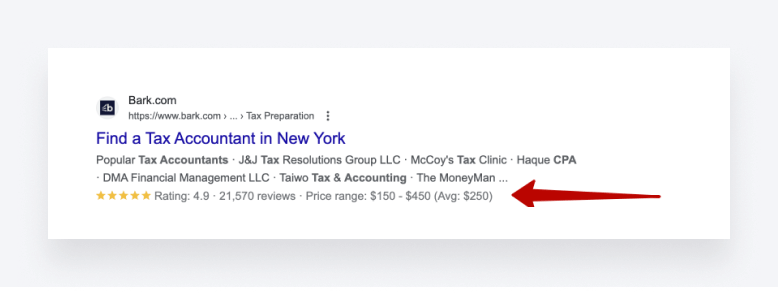
You’ll need different schemas for different content types — Google recognizes 35 different types in total. So it makes sense to categorize the content on your website. Once that’s done, you can follow these steps:
- Go to Google’s Structured Data Markup Helper
- Select the type of data you want to use
- Paste the web page’s URL or HTML source code
- Click “Start Tagging”
- Highlight the element you want to markup and tag it with the appropriate tag (name, author, image, etc.)
- Repeat for all elements of the page you want to add markup to
- Click “Create HTML”
- Copy the code and paste it into your web page
There are other tools and plug-ins you can use to do this, but Google’s tool is free and easily accessible. You can also use Google’s Rich Results Test tool to check your markup is implemented correctly.
This process might sound highly technical, but it’s fairly easy to get to grips with. The results are certainly worth it.
8. Drive engagement with SEO blogging
Blogs are a proven way to drive organic traffic to your website. By regularly publishing relevant and informative content, you can attract potential clients and establish yourself as a trusted and authoritative voice in the industry.
As an accounting firm, you can write blog posts about tax filing tips, changes in tax law, or other useful information that potential clients might want to know. The key here is to get people to your website. Once there, they can easily find out about your services.
When looking for relevant topics to write about, it can be helpful to look at what your competitors are publishing. Tools like Semrush allow you to analyze your competitors’ websites to understand which articles are driving the most traffic (see below).
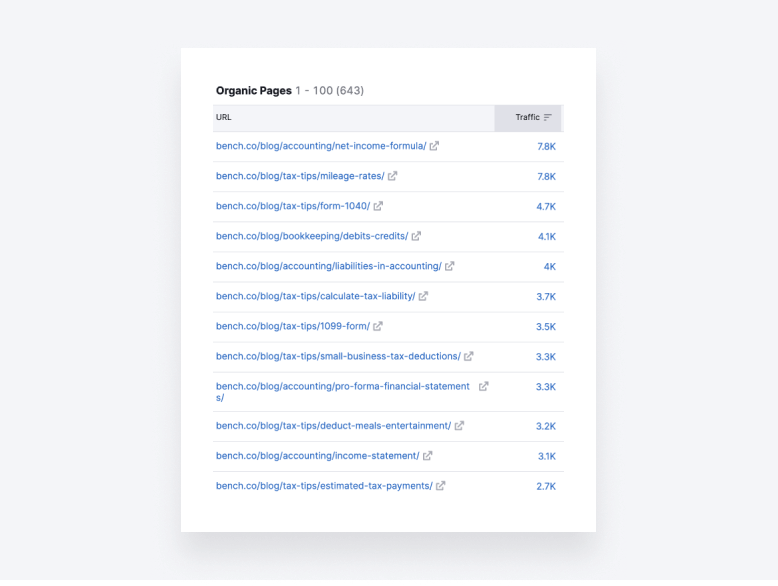
Analyzing other accounting blogs helps you understand the types of articles that resonate with your target audience. Then it’s a matter of writing high-quality, unique articles on similar subjects to capture some of that engagement.
You can leverage AI tools like ChatGPT to generate ideas and create blog outlines. Beware of asking AI tools to write your content for you, however. While this is much quicker than writing it yourself, Google penalizes content that looks AI-generated.
9. Capture local interest with Google My Business
If you want to attract interest from the local community, one effective strategy is to register your business with Google My Business. Think of this as an online business directory, where people can look up businesses in the local area.
Chances are you’ve already seen Google My Business listings in action — they’re the ones located on a map, with Google user reviews, opening times, and other key information attached. See the examples below.
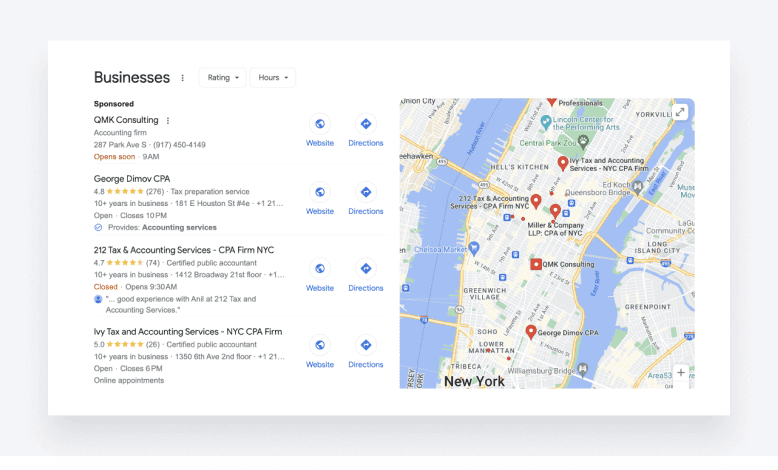
As you can see, getting listed on Google My Business enhances your firm’s visibility, especially among people looking for accountants in the local area. What’s more, your firm’s visibility via Google My Business is totally unrelated to your website’s SEO ranking. In fact, you don’t even need a website to get listed!
To get listed on Google My Business, you’ll need to follow these steps:
- Enter your business name here
- Select the business type from the available options
- Enter a business category, e.g. “accounting firm”
- Add the local area that your business serves
- Enter your contact information and website address
- Click “Finish”
You’ll then need to verify your business by email. You can choose whether to do this now or later.
If you have a brick-and-mortar business, it’s worth ensuring that your business address is visible to customers. To do this, go to your business profile, select the edit icon next to “Business location”, and toggle on “Show business address to customers”.
10. Build a strong link profile
When other reputable websites link to yours, Google sees this as a sign that your website is trustworthy and authoritative — and rewards you with better rankings. But how do you go about getting other businesses to link to yours?
One way is through high-quality content — other businesses may see your blog post on tax tips and place a link to it in their post to provide more context for their readers. Another strategy is to register your website and company on various business or accounting directories, which usually allow you to add a link to your website.
On top of this, you can reach out to businesses directly with the offer of a link exchange. This means in exchange for adding a link to their company, they’ll add one to yours. You can even offer to write guest posts. Win-win!
11. Don’t forget about internal links!
Internal linking is another powerful way to improve SEO. It also makes it easier for visitors to navigate your website and find the information they need.
The key here is to place internal links strategically throughout your content. Blog posts are an excellent way to do this. For example, you can write a post about tax preparation tips and then link to your tax services web page. You can also connect your blog posts through internal links, so readers can find out more about important topics.
Likewise, you can add links to your service pages to relevant blog posts, web pages, or case studies. See the example below.

Google favors websites that can demonstrate EAT. It shows the search engine that your business is credible, knowledgeable, and reliable — in other words, the type of website that accounting clients want to visit.
There’s no single way to demonstrate EAT. Rather, it’s a combination of strategies that aim to show Google that they are right to rank you highly. Let’s look at some examples:
- Publish authoritative content: publish regular blog posts that showcase your accounting expertise.
- Get backlinks from reputable sites: reach out to industry blogs, news websites, and other professional organizations to contribute guest posts or get featured in an article
- Showcase your credentials: display your accounting certificates and memberships, highlight how many clients you’ve helped and how long you’ve been in business
The more you can demonstrate your expertise, authority, and trustworthiness, the higher Google will rank you.
13. Convert traffic with CTAs and lead forms
Attracting SEO traffic is just the first step — you need a way to convert those leads as well. This is where calls to action (CTAs) and lead forms are essential.
CTAs are clickable links that you place in your web content to get the visitor to do something — schedule a meeting, sign up for a newsletter, or download an ebook, for example. You can place these strategically in your blog posts, home page, and service pages.
See the example below — a tax firm’s homepage with two CTAs: “Book an appointment” and “Get prepared”, which takes you to a handy tax checklist.
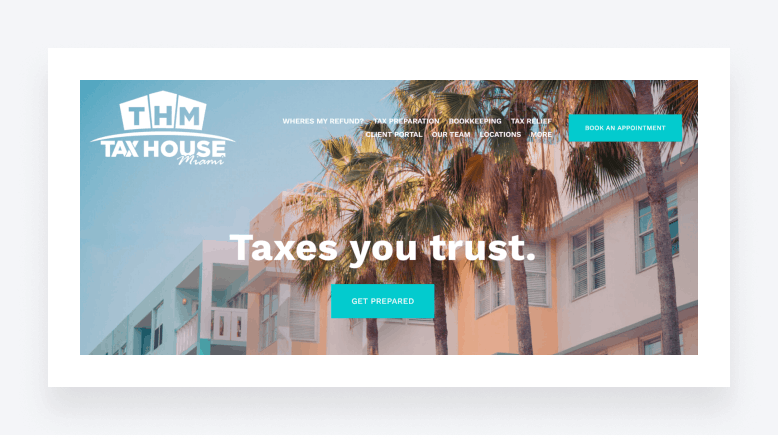
To capture visitor information, you can also use lead forms. These are digital forms that visitors complete as a first step to performing an action, such as signing up for a newsletter. By capturing people’s names and contact details, you can reach out directly to see how you can help.
At TaxDome, we always add targeted CTAs for our audience. For instance, as an accounting practice management software firm, we encourage visitors to book a demo, with clear CTAs that highlight the benefits of our software. This approach helps convert SEO traffic into valuable leads. See the example below!
Ready to take your practice to the next level? TaxDome offers all the tools you need to run a highly efficient and profitable accounting business.
Book a demo14. Ensure that your website is mobile-friendly
In 2023, 60% of online browsing time was spent on mobile devices. So if your website isn’t optimized for mobile, you run the risk of turning away over half of all traffic arriving on your site. Mobile-friendliness also impacts SEO, with Google primarily using the mobile version of a site for indexing and ranking.
To ensure that your website is mobile-friendly, you’ll need to implement responsive design. This ensures that your web pages adapt well to different devices and screen sizes. Most website builders have built-in responsive design, but it’s worth testing how your website looks on desktop, mobile, and tablet to ensure compatibility.
You can also use certain design features that save space and improve navigation, such as collapsable “hamburger” menus and pinned navigation bars. And because space is limited on phone screens, clean, minimalistic websites tend to be easier to navigate.
15. Update old content
Updating content can boost your SEO significantly, reviving old blog posts that have stopped bringing in steady traffic. Here are some ways you can update your blog content:
- Add new information: things change fast in accounting, so be sure to add the latest information, trends, and insights
- Update statistics: replace old stats with new ones to maintain credibility
- Update times and dates: if you wrote an article titled “How to file your taxes in 2023”, you’ll need to update the year to keep it relevant
You can then use tools like Google Analytics to see how your updates impact blog visibility.
16. Add alt texts for images
Alt text is a short text you can add to images to describe what they show. When people with visual impairments view your website, they use special software that reads the screen out loud for them, including alt text.
By adding alt texts, you improve your website’s accessibility, ensuring that anyone with a visual impairment can understand what your business offers. Alt texts also improve SEO by helping search engines understand the context of images on your site.
So remember to add alt text to all images — not just traditional photos, but also infographics, illustrations, graphs, and charts. You can do this directly in your website builder.
Measuring SEO success
The strategies above are tried-and-tested ways of improving SEO rankings and driving more traffic to your website. But to fully understand the impact of your SEO efforts, you need to measure and track performance over time.
There are plenty of great tools you can use to track SEO performance, from free options such as Google Analytics and Google Search Console to paid ones such as Ahrefs, Semrush, and Moz. All of these tools will allow you to track key metrics such as:
- Keyword performance: monitor your keyword rankings, track your competitors, and identify opportunities for improvement.
- Website traffic: track visitors, segment them by source, and differentiate between visitors who search for your business directly (branded) and those who find you using keywords (non-branded).
- Conversions: track how many visitors submit a contact form, download resources, or sign up for newsletters. You can set up conversion goals in Google Analytics and track specific events, such as button clicks or form submissions.
Tracking these three metrics will give you a solid understanding of how your website is performing over time, giving you the insights you need to fine-tune and improve your SEO strategy.
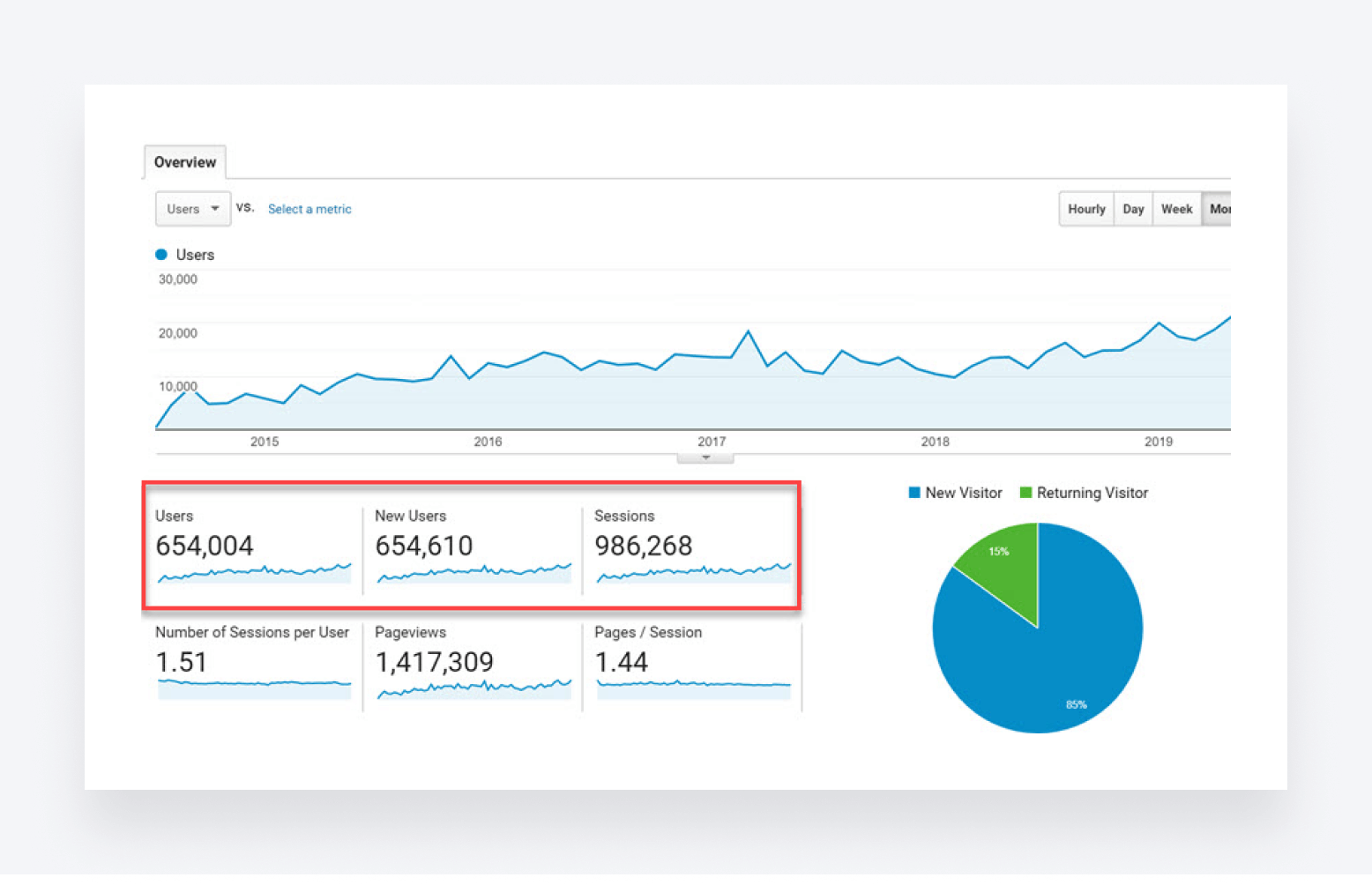
Wrapping up
Optimizing your firm’s online presence through SEO is the key to unlocking a steady stream of traffic and attracting new clients. But while SEO can seem complicated at first, it’s relatively easy to make a tangible difference to your website’s ranking. The strategies we’ve outlined in this article are a great place to start.
Of course, SEO is just one aspect of running a successful, forward-thinking accounting practice. In addition to a high-performing website, you need the right technology to manage your clients, teams, projects, and workflows. This is where TaxDome comes in.
Book a demo today to see our award-winning practice management platform in action!

Thank you! The eBook has been sent to your email. Enjoy your copy.
There was an error processing your request. Please try again later.
Looking to boost your firm's profitability and efficiency?
Download our eBook to get the answers



